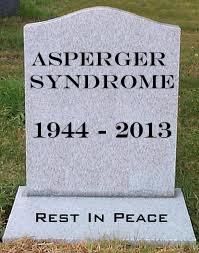Asperger's Syndrome
After Asperger's, What Diagnosis Comes Next?
Some will likely not be considered autistic
Posted December 4, 2012

A memorial to Asperger syndrome by Andrew I. Lerner. This autism profile was first described in a 1944 paper by Hans Asperger.
The APA has shown Asperger’s the door, as promised — or as threatened, depending on viewpoint. It didn’t go quietly. Many of us liked Asperger’s and are sorry to see it leave. Crowds of people wouldn’t be here if Asperger’s hadn’t brought them. But others are tired of Asperger’s overshadowing its peers. What exactly is Asperger’s anyway? No one seems sure. Asperger’s can look just like the rest, but some say it has little in common with them at all. The APA insists there’s too much of it.
To translate from Neurotypical (removing the metaphor), Asperger’s as diagnostic terminology will soon be eliminated from the Diagnostic and Statistical Manual of Mental Disorders. Which is to say, Asperger syndrome has been renamed. In theory, Aspergerians and those who currently meet the criteria for other forms of autism will move into the all-new, catch-all Autism Spectrum Disorder category (ASD).
Like? Or dislike?
At the Asperger’s Association of New England (AANE), based in Watertown MA, the mood is uneasy. Many of the founding members of this organization were involved in the long advocacy effort to have Asperger syndrome recognized as a form of autism. Success came in 1994 when Asperger’s Disorder was incorporated into the DSM. Until then, people with non-classically autistic profiles were subject to inaccurate diagnoses that didn’t help them understand or address their challenges (mix and match from this list: attention deficit disorder, schizoid affective disorder, anxiety disorder, childhood bipolar disorder, depressive disorder, sensory integration disorder, obsessive compulsive disorder). Those who were more appropriately diagnosed with autism nevertheless struggled to find services geared towards their needs.
“I got routed into depression and anxiety diagnoses for years, because therapists did a bang-up job of misdiagnosing a neurological issue as a psychological one," said an autistic author on Facebook yesterday (reprinted with permission). "I wasn't anxious; I was overloaded and over-stimulated. I wasn't depressed; I was exhausted by the effort to pretend to be normal when I didn't know why I was pretending in the first place. I think the Asperger's diagnosis saved my life. I still qualify for the ASD one, but I’d hate to think of people further toward the border between Asperger syndrome and Neurotypical ending up with heavy-duty psychiatric diagnoses (and the meds that come with them).”
Could this happen again? Members of the panel responsible for the revisions insist that those who meet DSM-IV criteria for Asperger's or Pervasive Developmental Disorder Not Otherwise Specified (PDD-NOS) will be diagnosed with Autistic Spectrum Disorder as the DSM-5 defines it. But they have said other things, too, including (repeatedly) that the new diagnostic criteria will address the “over-diagnosis” of Asperger’s and autism — a phenomenon that hasn’t been demonstrated by research. Several studies have indicated that significant percentages of people with Asperger’s and PDD-NOS profiles might lose their autism diagnoses under the DSM-5 criteria. One of the most persuasive, says science writer Emily Willingham, "calls into question blithe assurances that people who might fit current Asperger’s and PDD-NOS diagnoses have nothing to worry about." Ten per cent of children who meet current criteria for autism spectrum conditions could be excldued, the study suggests.
Some will likely pick up other diagnoses, including social communication disorder, a new category designed to capture people with social and communication challenges who don't exhibit the repetitive behaviors and restricted interests common to autism. One of the big unknowns around DSM-5 is whether this diagnosis will properly identify and address the needs of those who receive it.
“My concern is that people with Asperger traits will get the diagnosis of social communication disorder which will not adequately describe the neurological complexity of who they are, their strengths and challenges,” says Dania Jekel, Executive Director of the AANE. “Or they may not get a diagnosis at all, which will leave people floundering, echoing the situation prior to the identification of Asperger syndrome.” (She adds, “Whatever the outcome, AANE will still be here to serve those people on or off the autism spectrum who can use our help.”)
The Autistic Self-Advocacy Network (ASAN) likewise concludes that social communication disorder — which will not be considered a form of autism — may seriously threaten access to educational services, legal protections, Social Security programs and public health insurance for some. (The policy brief also identifies potential benefits of the new criteria.)
And then there's the issue of implementation by cash-strapped school administrators and other providers of services and support. The social communication disorder "option" might embolden school administrators to resist autism diagnoses more aggressively. In that scenario, the biggest losers will be children whose families lack the resources to bring in opposing expert opinions and engage in legal battles.
Various autism and Asperger's organizations are looking at ways to mitigate and avoid harmful effects of the DSM changes. More info here as the story evolves.
About the gravestone illustration:
Yes, an unexpected choice for a blog titled Asperger's Alive! But while I hope and believe the Asperger's nomenclature will endure for those who want it, the DSM transition and its uncertainties invoke anxiety around self-identity for many Aspergerians. The gravestone was designed by Andrew I. Lerner of LernerGraphics.com. He wrote: "As of May 2013, I will be autistic, and have autism. Asperger's Syndrome will cease to exist. The only cure for it was to eliminate its existence in the DSM-5. I will be relegated to a spectrum where you will not be able to see me. Many of my graphics will no longer be valid or recognized."




